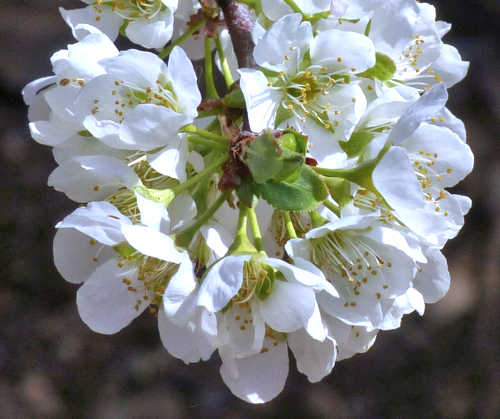Growing Plums, Pluots and Pluerrys:
Prunus salicina
Back to Fruit, Berries and Nuts
Botanical Overview
Plums, members of the Prunus genus and the Rose family, are closely related to apricots, cherries, peaches, and almonds. While up to 40 species can be called plums, only three are grown commercially. Crosses between plums and apricots, called pluots, plumcots, apriplums, or apriums, depending on the ratio of plum to apricot, are popular. A new cross, known as pluerry, is a mix of plum and sweet cherry.
Description
Form:
Tree.
Lifespan:
15-25 productive years.
Leaf retention:
Deciduous.
Growth rate:
Moderate.
Mature Size:
The rootstock and cultivar determine size.
Most residential cultivars are 20' (6m) high and wide.
Flowers:
White to pink, five petals. Japanese plum flowers are more clustered and numerous than those
of the European plum.
Bloom:
Late winter or spring. Japanese plums bloom earlier than European ones and are more likely
to encounter late frost.
Self-fruitful:
Most cultivars, but not all, need a different cultivar nearby to provide pollen.
Years before fruiting:
3.
Fruit:
Round to oval in shape, smooth skin that can be dark blue, purple, red or yellow, having
juicy flesh. A single seed is enclosed in a hard woody shell.
Months for fruit to ripen:
2.5 - 6.
Storage after harvest:
Unripe (hard) plums should be left at room temperature in a bowl for several days until
ripe.
After that, they can be placed in a crisper drawer of a refrigerator up to one week.
Eat as soon as possible. Slice, remove the pit, and freeze for longer storage.
Leaves:
Green, oval to lance-shaped.
Stems:
Some cultivars may have thorns.
Roots:
Cuttings are grafted onto a compatible Prunus rootstock.
Some rootstocks reduce the size of the tree, some are disease resistant.
Species of Note:
Prunus salicina: Japanese Plum - produces the largest
fruit and is grown for the fresh plum market in the United States.
'Santa Rosa' 300 chill hours, self-fruitful, very
heat tolerant.
Prunus domestica: European Plum - grown for dried
plums (prunes).
Prunus insititia: Damson Plum - a plum with smaller
fruit, used for jams and jellies.
Prunus salicina x armeniaca: Pluot -
three-quarters Japanese Plum and one-quarter Apricot.
'Flavor Grenade' 300-400 chill hours,
cross-pollinate with another plum or pluot.
Prunus salicina x avium x: Pluerry - a hybrid
composed principally of Japanese plum and sweet cherry.
Wildlife:
The flowers attract bees. The fruit attracts birds and mammals.
Toxic / Danger:
Seeds and leaves contain small amounts of cyanide.
Origin:
Prunus salicina - China, P. domestica - Western Asia, P. insititia - Europe.
Cultivation and Uses
USDA hardiness zones:
4-9.
Chill hours:
Trees with chill hours of 300 or less are more likely to flower and fruit in desert climates.
Heat tolerant:
True for at least one cultivar.
Drought tolerant:
True for at least one cultivar.
Sun:
Full sun.
Planting:
Locate the tree in morning full sun with afternoon shade. Being in a low area where cold air
collects, and where the root area and trunk are in shade during winter, may help with winter
chill hours, although the flowers will be more susceptible to damage by late frosts. The soil
in that location must be well draining and slightly acidic to acidic.
Any caliche layer must be removed. Dig the planting hole twice the width of the rootball.
Soil:
Well draining, deep, pH 5.6-6.5 (acidic to slightly acidic). Plums are not salt tolerant.
Fertilize:
Apply an organic fertilizer for acid loving plants once in early spring. Spread the
fertilizer evenly out to the drip line and 1' away from the trunk.
Water after becoming established:
Deep water every 10-14 days in warm months to
increase resistance to insect predation. Deep water monthly in winter.
Mulch:
Spread mulch every spring, inside the drip line and 8" (21cm) from the trunk, to retain soil
moisture.
Remove mulch in the fall so pests cannot use it to over-winter.
Prune:
In late winter or early spring, remove dead, crossing or damaged branches. Remove unwanted,
excess new growth. Flowers bloom on one-year and older wood.
Remove excess marble-sized young fruit so that only one is present every 6-8" (15-21cm) along a branch to avoid branch breakage.
Remove any weeds growing under the canopy to avoid competition for nutrients.
Remove excess marble-sized young fruit so that only one is present every 6-8" (15-21cm) along a branch to avoid branch breakage.
Remove any weeds growing under the canopy to avoid competition for nutrients.
Litter:
Leaves, and fruit if not harvested, in fall.
Propagation:
Cuttings grafted on special rootstock. Seed does not come true and the quality of the
resulting fruit is uncertain.
Uses:
Edible fruit, ornamental.
Do you have additional information or a different experience for these plants that you would like to share? Email info@GardenOracle.com. All contributions are welcome and appreciated.


Japanese Plum flowers and fruit
Latest update: February, 2021
© 2008-2025 by GardenOracle.com

